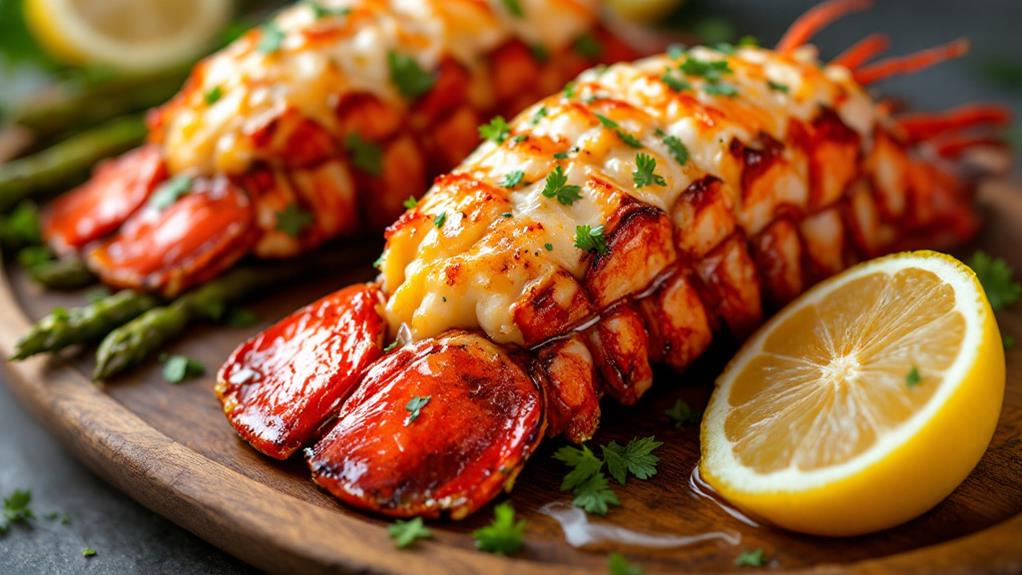When you think about butter seared lobster tails, you're likely envisioning a dish that elevates any dining experience. The combination of sweet, tender lobster meat and rich, velvety butter can create a memorable meal, but the key lies in how you prepare it. You'll want to consider the selection of fresh lobster tails and the essential cooking ingredients that can make all the difference. Once you grasp these fundamentals, you can explore the nuances of flavor enhancements that will take your lobster tails to another level. So, what makes the perfect butter blend for this dish?
Key Takeaways
- Select fresh lobster tails with hard shells, firm texture, and a slightly briny aroma for optimal flavor and quality.
- Prepare a rich butter blend, incorporating garlic, herbs, and lemon juice for enhanced taste.
- Sear the lobster tails in a preheated skillet, basting with melted butter for a golden crust and added flavor.
- Cook to an internal temperature of 140-145°F to achieve tender, buttery lobster meat without overcooking.
- Serve with complementary side dishes and a suitable wine pairing, such as Chardonnay or sparkling wine, to elevate the dining experience.
Selecting Fresh Lobster Tails
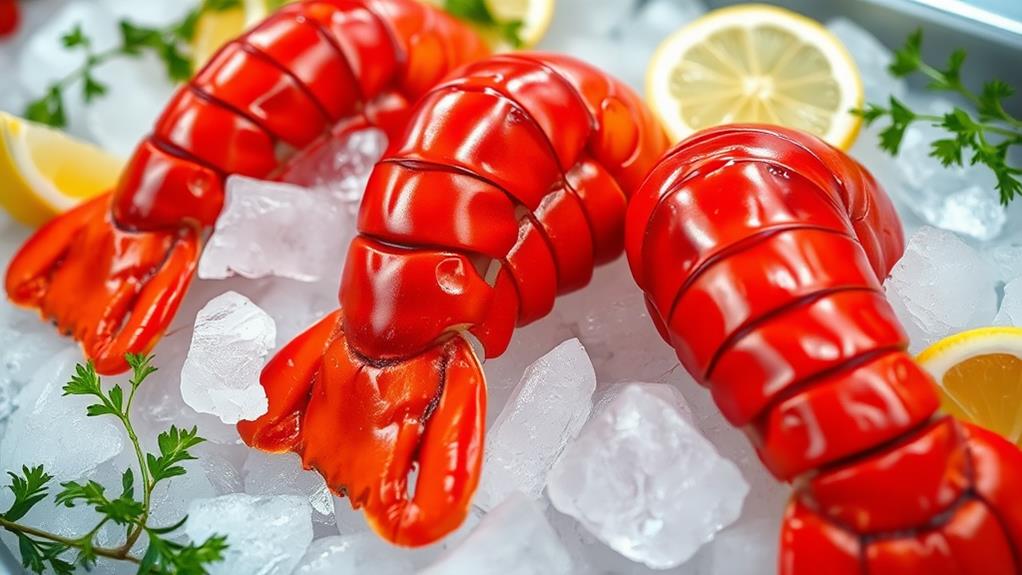
When you're on the hunt for the perfect lobster tails, fresh is the name of the game. You'll encounter several lobster tail varieties, each with unique flavors and textures. When selecting your lobster tails, focus on freshness indicators that will ensure you're getting the best quality.
Start by examining the shells. They should be hard and intact, devoid of any cracks or discoloration. A fresh lobster tail also has a slightly briny aroma, reminiscent of the ocean. If it smells overly fishy, steer clear.
When you pick them up, the tails should feel firm, not mushy. A fresh tail will also have a vibrant color; look for shades of red, green, or brown, depending on the variety you choose.
Another helpful tip is to check for the tail's flex. A fresh lobster tail should bend back but not break. If you can find tails that are still alive, even better! But if that's not an option, buying from reputable sources can ensure you're getting top-notch lobster tails.
Essential Cooking Ingredients
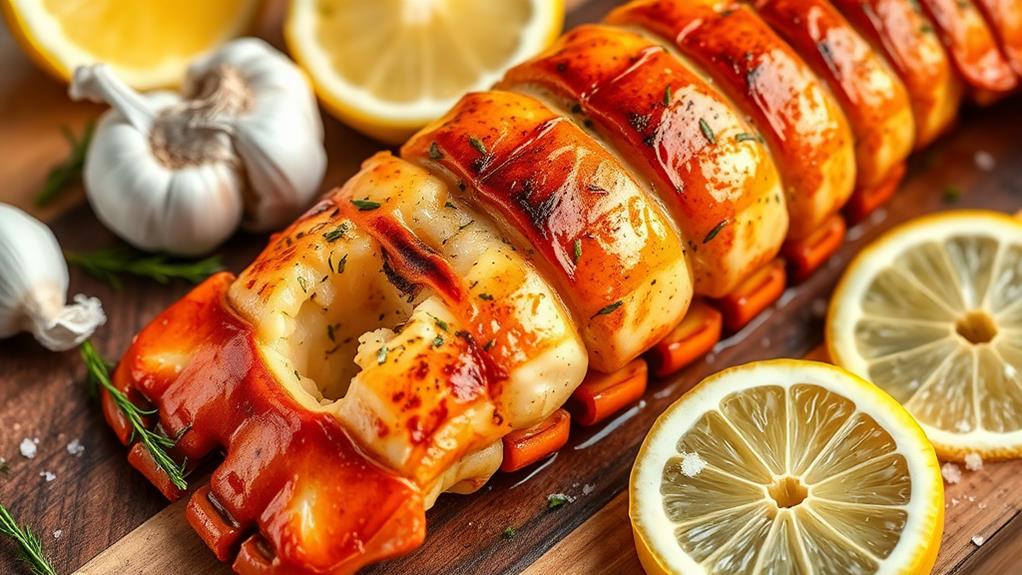
A few essential ingredients can elevate your butter-seared lobster tails from good to unforgettable.
First and foremost, you need high-quality butter. Opt for a rich, creamy variety that melts beautifully and enhances the natural sweetness of the lobster. This butter will serve as your cooking medium, providing a luscious base for flavor.
Next, don't underestimate the power of aromatic herbs. Fresh herbs like parsley, thyme, or tarragon can add a delightful freshness to your dish. Chop them finely and toss them into the sizzling butter just before you add the lobster tails. This step infuses the butter with fragrant notes, creating a mouthwatering aroma that beckons everyone to the table.
Another essential ingredient is garlic. A few minced cloves sautéed alongside the butter and herbs will impart a warm, savory depth that complements the lobster perfectly.
Finally, consider a squeeze of fresh lemon juice to finish your dish. That bright acidity will balance the richness and elevate the overall flavor profile.
With these essentials, your butter-seared lobster tails will be a culinary masterpiece that delights the senses and impresses your guests.
Preparing the Lobster Tails

Preparing lobster tails is a straightforward process that sets the stage for a delicious meal. Start by gathering your cooking equipment: a sharp knife, kitchen shears, and a cutting board. Place the thawed lobster tails on the cutting board, shell side down.
Using the kitchen shears, cut down the center of the shell from the wide end toward the tail, being careful not to cut through the meat. This lobster tail preparation technique allows you to easily access the succulent meat inside. Once you've made the cut, gently pull the shell apart, exposing the tender lobster meat.
Next, you can lift the meat slightly out of the shell, resting it on top for an elegant presentation. Rinse the tails under cold water to remove any debris, and pat them dry with a paper towel. This step is crucial, as it ensures a good sear later on.
Now that the tails are prepped, you're ready to move on to the cooking process, where that beautiful butter blend will elevate your dish to new heights. Enjoy the anticipation of savoring your perfectly prepared lobster tails!
The Perfect Butter Blend
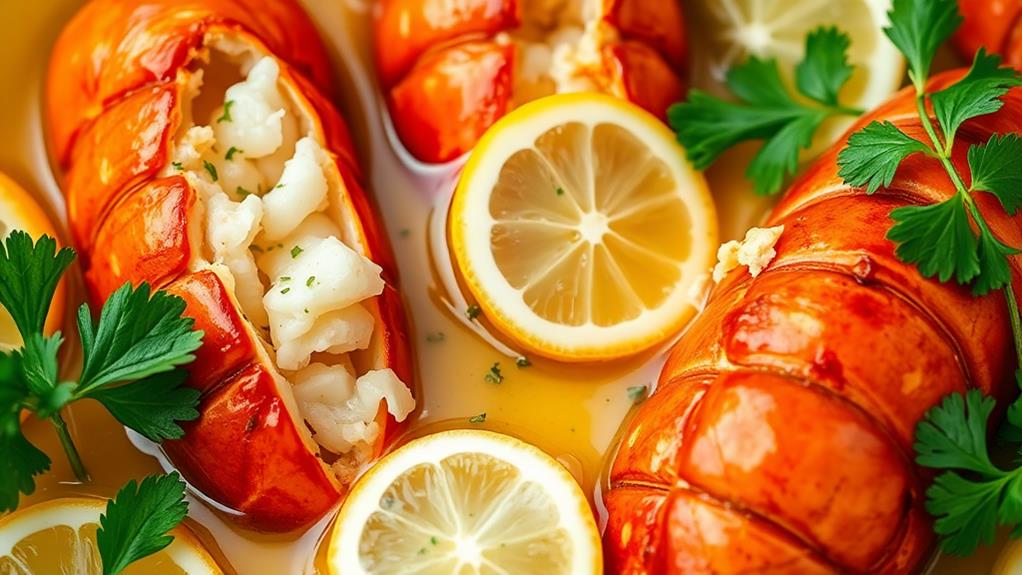
The perfect butter blend transforms your lobster tails into a culinary masterpiece, infusing them with rich flavor and luxurious texture. By choosing the right butter types and achieving a harmonious seasoning balance, you can elevate your dish to new heights.
Imagine a blend that combines the creaminess of unsalted butter with a hint of garlic and a splash of lemon juice. This creates a delightful contrast, enhancing the natural sweetness of the lobster. Here's a simple breakdown of your ideal butter blend:
| Butter Type | Flavor Profile |
|---|---|
| Unsalted Butter | Creamy, rich base |
| Garlic Butter | Aromatic, savory depth |
| Lemon Butter | Bright, zesty freshness |
| Herb-Infused Butter | Earthy, fragrant notes |
| Spicy Butter | Warmth and excitement |
When crafting your butter blend, ensure the seasoning balance is spot on. A touch of salt, fresh herbs, and a dash of pepper can enhance the flavors without overpowering the delicate lobster. With this perfect blend, you'll create an unforgettable experience, making your lobster tails the star of the show.
Searing Techniques for Lobster
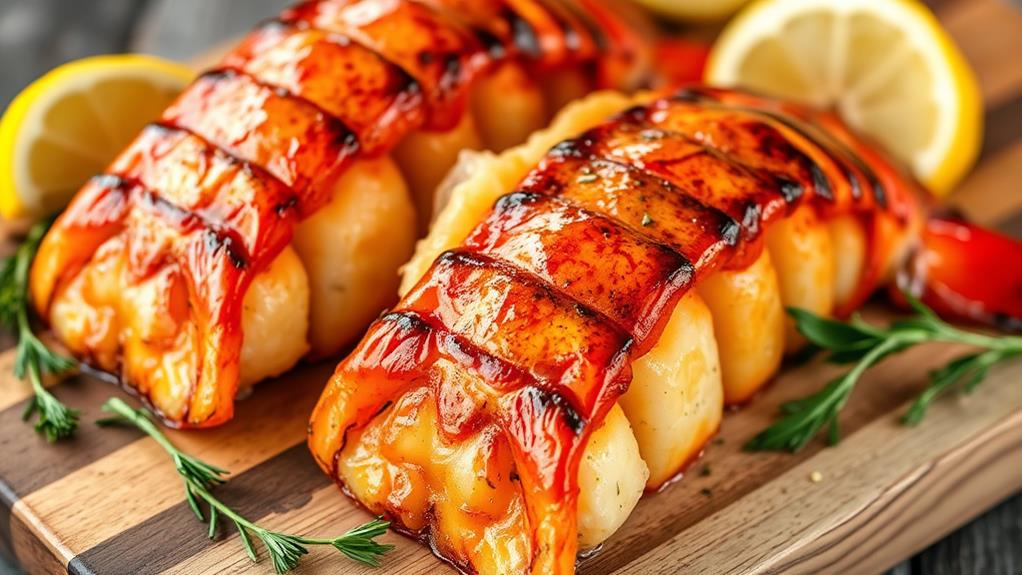
Sear your lobster tails to perfection and unlock a world of flavor and texture. Mastering the art of searing transforms your lobster into a succulent dish that tantalizes the taste buds.
Whether you opt for sous vide to ensure a precise cook or go straight to the skillet, the goal is the same: achieving that irresistible sear.
Here are some searing techniques to elevate your lobster:
- Preheat your pan: Ensure your skillet is hot enough to create those coveted grill marks.
- Use high-quality butter: It not only adds flavor but also helps achieve a beautiful golden crust.
- Sear in batches: Avoid overcrowding the pan to maintain that perfect heat, giving each tail room to develop a proper sear.
- Baste while cooking: Spoon the melted butter over the tails for a rich, buttery flavor that seeps into the meat.
- Finish with a quick broil: For added caramelization and to enhance those grill marks, broil for a minute after searing.
Achieving the Ideal Cook

When it comes to achieving the ideal cook for lobster tails, timing and temperature are crucial elements that can make or break your dish. You want to ensure that the lobster tails are cooked precisely to achieve that perfect balance of buttery richness and tenderness. Overcooking can lead to tough, rubbery textures, while undercooking may leave you with a chewy bite.
To help you understand the importance of cooking temperatures and their effect on lobster tail textures, here's a quick reference:
| Cooking Temperature (°F) | Texture | Cooking Time (Minutes) |
|---|---|---|
| 140-145 | Tender, buttery | 7-10 |
| 145-150 | Firm, juicy | 10-12 |
| 150-155 | Slightly chewy | 12-15 |
| 155+ | Tough, rubbery | 15+ |
Aim for that sweet spot of around 140-145°F for the best results. Using an instant-read thermometer can help you monitor the temperature accurately. Trust your instincts and enjoy the process; after all, perfectly cooked lobster tails are a culinary delight!
Flavor Enhancements and Additions
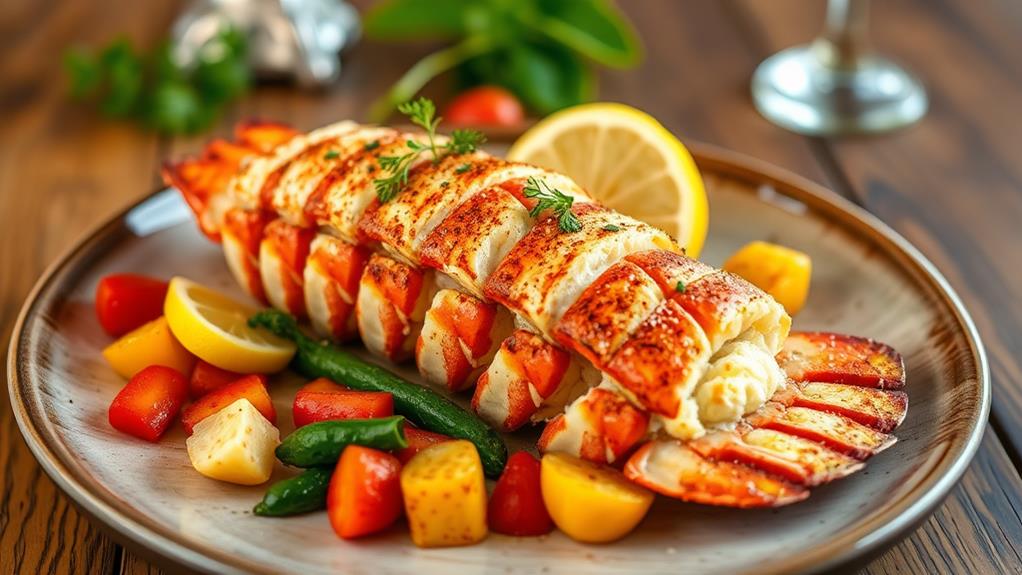
A variety of flavor enhancements can elevate butter-seared lobster tails to new culinary heights. By incorporating unique elements, you can create a dish that tantalizes the palate and impresses your guests.
Start by experimenting with herb infusions, as they can infuse the rich butter with aromatic flavors. Consider adding fresh thyme, rosemary, or tarragon to your melted butter for a delightful twist.
Citrus zesting is another fantastic way to brighten the dish. A sprinkle of lemon or lime zest adds a refreshing zing that complements the richness of the lobster.
Here are some other enhancements to consider:
- Garlic: Sauté minced garlic in butter for a savory depth.
- Chili Flakes: Add a pinch for a touch of heat.
- White Wine: Deglaze the pan with white wine for added complexity.
- Parmesan: Grate a little over the lobster before serving for extra richness.
- Truffle Oil: Drizzle a few drops for an indulgent finish.
With these enhancements, your lobster tails won't only taste incredible but also look stunning on the plate.
Enjoy the process of experimenting and discovering your perfect flavor combination!
Serving Suggestions
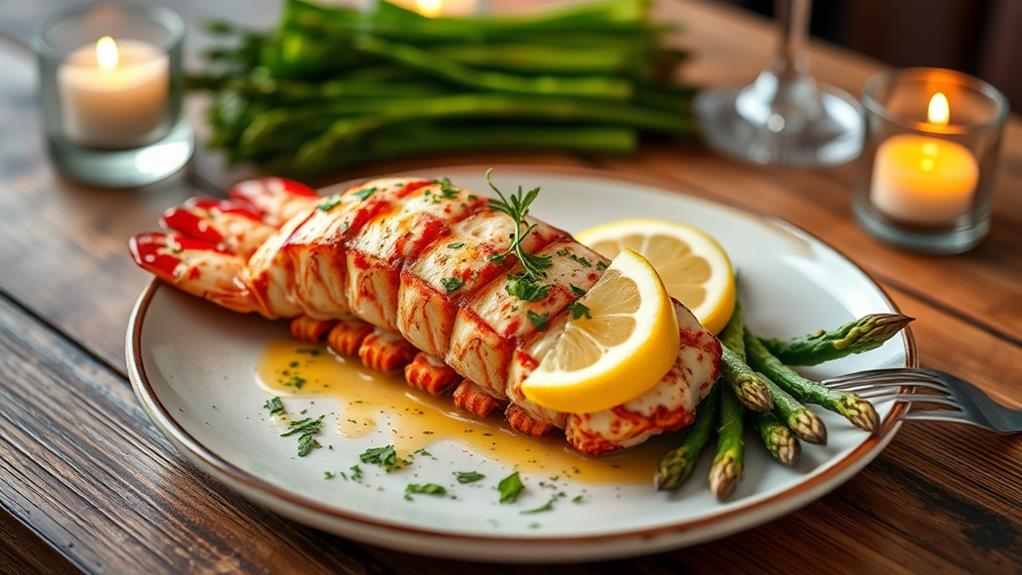
After enhancing the flavors of your butter-seared lobster tails, it's time to think about how to serve them for maximum impact. Start by placing the succulent tails on a stylish platter, showcasing their golden, buttery sheen.
For an elegant touch, consider drizzling a flavorful sauce over the tops. Options like a zesty lemon garlic butter or a rich herb-infused sauce can elevate the dish, adding complexity to each bite.
Pair your lobster tails with complementary side dishes that balance their richness. Garlic mashed potatoes or a light, citrusy arugula salad work beautifully, providing a refreshing contrast.
You might also opt for grilled asparagus or sautéed seasonal vegetables, bringing color and texture to the plate.
Don't forget to add a splash of color with garnishes like fresh herbs or lemon wedges. This not only enhances the visual appeal but also invites your guests to indulge in the vibrant flavors you've created.
With the right sauce options and side dishes, your butter-seared lobster tails will be a feast that pleases both the eye and palate. Enjoy the admiration from your guests as they savor every delicious bite!
Wine Pairing Recommendations
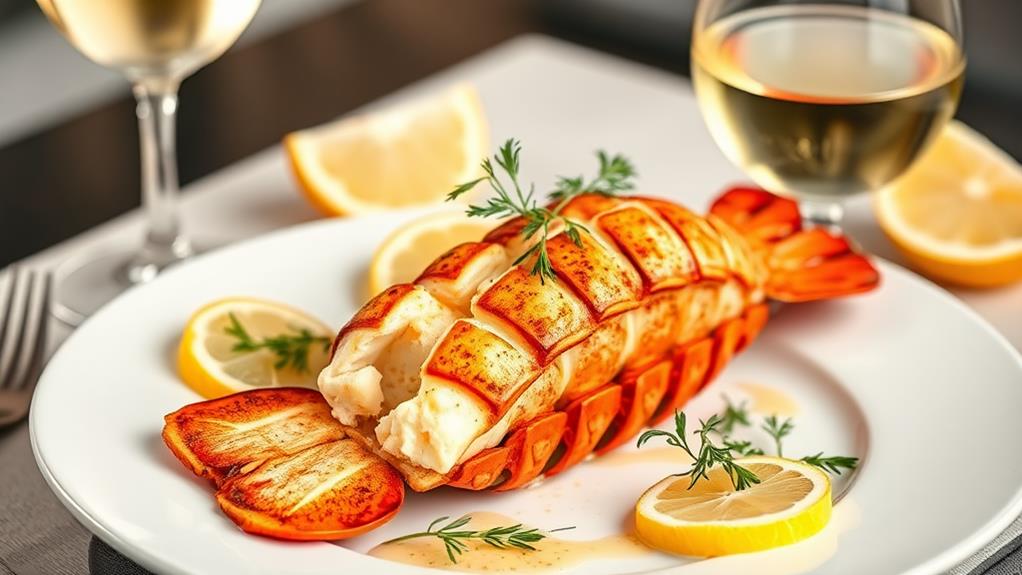
Choosing the right wine to accompany your butter-seared lobster tails can elevate your dining experience to new heights.
The rich, buttery flavor of the lobster calls for wines that complement its luxurious texture without overpowering it. Here are some excellent pairing options to consider:
- Chardonnay options: A creamy, oaked Chardonnay enhances the buttery essence of the lobster, while a crisp, unoaked variety provides a refreshing contrast.
- Sparkling pairings: A dry Champagne or sparkling wine adds a delightful effervescence that cuts through the richness, enhancing each bite.
- Sauvignon Blanc: This wine's zesty acidity and herbal notes can balance the richness of the butter while adding a refreshing twist.
- Pinot Grigio: A light and crisp Pinot Grigio serves as a perfect complement, with its fruity undertones highlighting the sweet flavors of the lobster.
- White Burgundy: This elegant choice, with its mineral notes and complexity, mirrors the sophistication of the dish.
Experiment with these suggestions to find the perfect match for your seafood feast, ensuring an unforgettable culinary experience.
Cheers to a delightful pairing!
Tips for Cooking Success
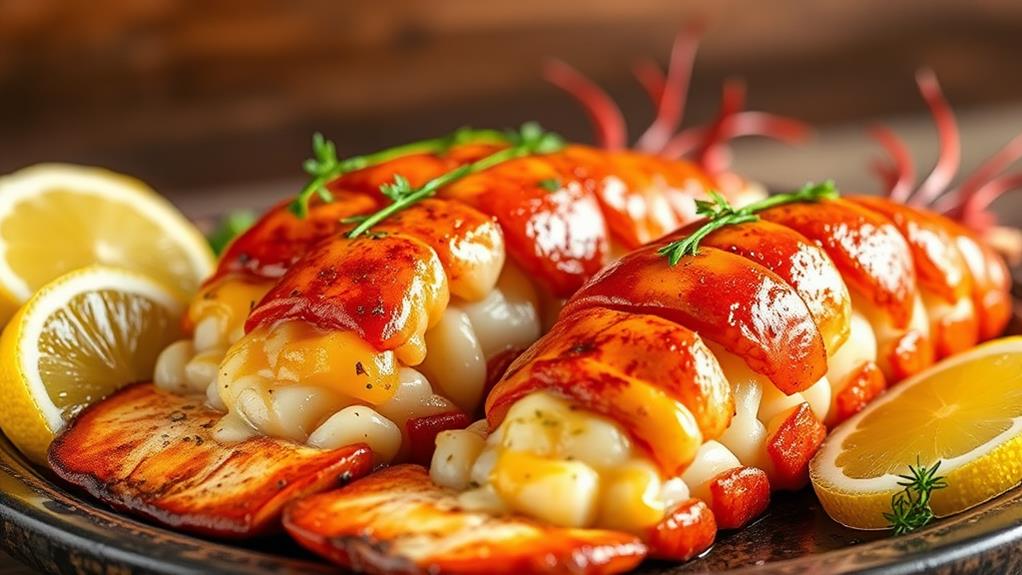
Pairing your butter-seared lobster tails with the right wine sets the stage for a remarkable dining experience, but the success of the dish itself hinges on your cooking technique.
First, ensure you've sourced the best quality lobster tails. Freshness is key, so buy from reputable suppliers or local fish markets. Look for tails that are firm, with a slight ocean scent—this indicates freshness.
Next, invest in quality cooking equipment. A heavy-bottom skillet or cast-iron pan distributes heat evenly, making it perfect for searing. Don't forget your tools: a sharp knife for splitting the shells and a basting brush to apply that luscious butter.
When cooking, control your heat. Start on high to get a nice sear, then reduce it to allow the tails to cook through without burning the butter.
Timing is crucial; overcooking can lead to rubbery meat. Aim for about 5-7 minutes per side, depending on the size of the tails.
Frequently Asked Questions
Can I Use Frozen Lobster Tails for This Recipe?
Absolutely! Using frozen lobster tails can elevate your dish, given you master the right cooking techniques. Thaw them properly, and you'll enjoy a delightful seafood experience that feels just as fresh and flavorful.
How Long Can Cooked Lobster Tails Be Stored in the Fridge?
You can store cooked lobster tails in the fridge for up to three days. For seafood safety, keep them in an airtight container. Always check for freshness before enjoying your delicious leftovers. Happy feasting!
What Are the Signs of Overcooked Lobster Tails?
To tell if lobster tails are overcooked, look for a rubbery texture and a dull color. Mastering lobster cooking techniques ensures tenderness and flavor, preventing that disappointing, tough outcome you want to avoid.
How Do I Properly Thaw Frozen Lobster Tails?
To properly thaw frozen lobster tails, you can use cold water immersion or overnight refrigeration. Both techniques maintain lobster quality, ensuring a tender texture. Just remember, patience and the right method yield the best results!
Can I Substitute Butter With Another Cooking Fat?
Absolutely, you can substitute butter with alternative fats like olive oil or ghee. Each adds unique flavor profiles, enhancing your dish in different ways, so experiment and find the perfect match for your culinary creation!
